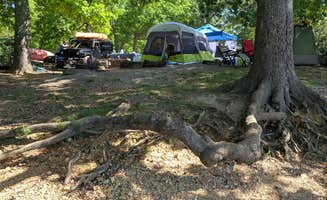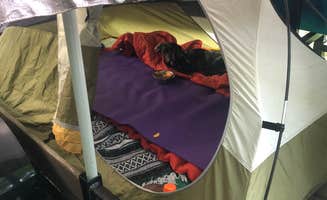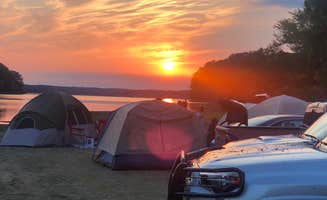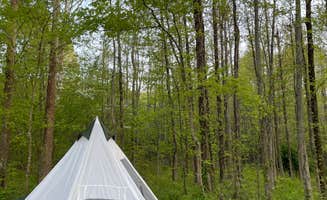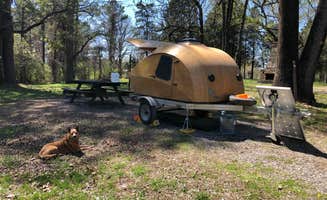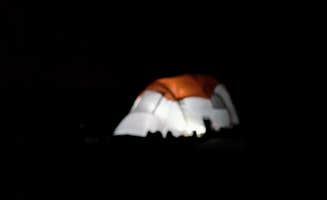Tent camping around Eddyville, Kentucky centers primarily on the 170,000-acre Land Between the Lakes National Recreation Area, with most sites positioned at elevations between 350-400 feet above sea level. The area experiences hot, humid summers with average July temperatures reaching 90°F, while spring and fall provide more moderate camping conditions with temperatures between 60-75°F. Winter camping remains viable with proper gear as temperatures rarely drop below 20°F for extended periods.
What to do
Kayaking and water access: At Cravens Bay Campground, tent campers find multiple water entry points for paddling. "Great spot for kayaking and tent camping. We were the only ones there so it was perfect! Highly recommend for tent camping," notes Benjamin C. Water levels fluctuate seasonally, with summer offering the most consistent paddling conditions.
Wildlife viewing: Forest Service Road 343 provides access to both camping and wildlife observation. "On the way in or out would recommend seeing the buffalo," suggests Katie. The Elk & Bison Prairie sits approximately 15 miles south of most Eddyville tent sites, with dawn and dusk offering optimal viewing times.
Star observation: Clear nights at remote tent sites offer exceptional stargazing opportunities. "Nice and quiet, beautiful stars at night," reports Scott B. about his November stay at Sugar Bay Campground. Light pollution remains minimal throughout the recreation area, with sites on higher elevations providing the most unobstructed views.
What campers like
Secluded shoreline access: Many tent campers value waterfront spots. "This campsite is on a small peninsula, just big enough for a large two room tent, a makeshift fire ring, and a vehicle," writes Staci R. about LBL FS154. Winter pool levels expose additional shoreline walking areas at many sites.
Uncrowded tent areas: Visiting during weekdays virtually guarantees solitude at most tent sites. "We love all the bays and coves at LBL. We prefer less crowded camp areas and that is what Sugar Bay offers," writes Brittni F. Occupancy typically remains below 30% midweek even during peak summer months.
Natural camping surfaces: Smith Bay Campground offers tent-friendly terrain. "We stayed at a site right off the water. We kayak so it was perfect for us to leave them on the shoreline so we could come and go as we please. It is a rocky beach but very clean," reports Kirstin A. Most tent sites feature compacted natural surfaces rather than constructed pads.
What you should know
Permit requirements: Backcountry and dispersed tent camping requires permits. "Be sure to have your dispersed camping permit before coming out! They are available online, and at any of the Visitor's centers," advises Staci R. Current dispersed camping fees run $10 per night or $5 with a National Park pass.
Water availability: No potable water exists at most tent sites. "There is also NO POTABLE water, so you either pack it in or bring your filter and drink lake water," explains a reviewer at LBL FS154. The nearest reliable water source is typically Golden Pond Visitor Center, approximately 12-15 miles from most tent camping areas.
Road conditions: Access to remote tent sites varies seasonally. "The road is gravel and bumpy so you might not want to take a smaller car on it but just fine for any awd, truck, van, etc," notes Katie about Forest Service Road 343. Spring rains often create temporary access issues requiring higher clearance vehicles.
Toilet facilities: Facilities range from none to basic. "There is still a central pit toilet that is cleaned regularly but can still get smelly during the heat of the day," Michael W. notes about Twin Lakes Campground. Most dispersed tent sites have no facilities, requiring proper cat hole sanitation practices.
Tips for camping with families
Beach access consideration: Some tent sites offer better swimming conditions for children. "Just a short paddle away are some sandy beaches. (These can get quite busy on weekends!)" advises Michael W. about tent camping near Smith Bay. The most family-friendly swimming beaches typically face south or southwest, warming earlier in the season.
Wildlife awareness: Securing food properly prevents unwanted visitors. "Raccoons and skunks visit the campsites nightly, so you must keep everything put away or risk a big mess like some we saw who had left there food out on a screened gazebo/tent," warns a camper at Smith Bay. Storing food in vehicles provides the most reliable protection.
Group site options: Old Boy Scout Campground accommodates larger family groups. "This place has no amenities. However the road is very close with energy lake campground nearby if you need firewood or anything else that you may run out of," notes Brad H. The site offers space for several tents with easy vehicle access.
Tips from RVers
Generator etiquette: At tent-oriented sites, generator use requires consideration. "Generators are only allowed during the day. However, there is no one to enforce this," explains Michael W. about camping at Smith Bay. The lack of consistent enforcement makes communication between campers essential for maintaining site harmony.
Site leveling challenges: RV campers face terrain limitations at tent-focused areas. "I suspect this is because the sites are not very level," notes a review about why Smith Bay primarily attracts tent campers rather than RVs. Bringing additional leveling blocks helps RV campers adapt to these predominantly tent-oriented locations.



